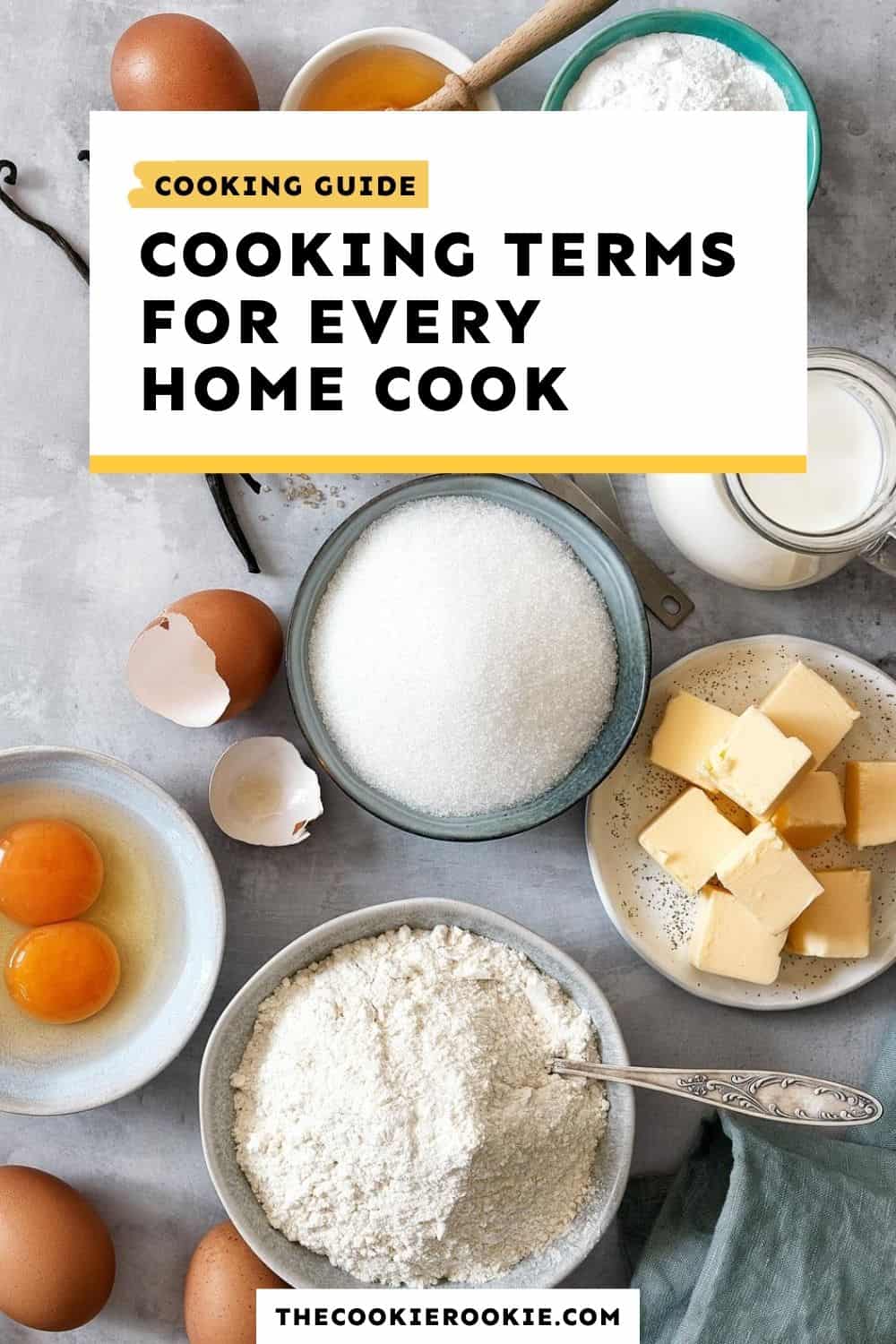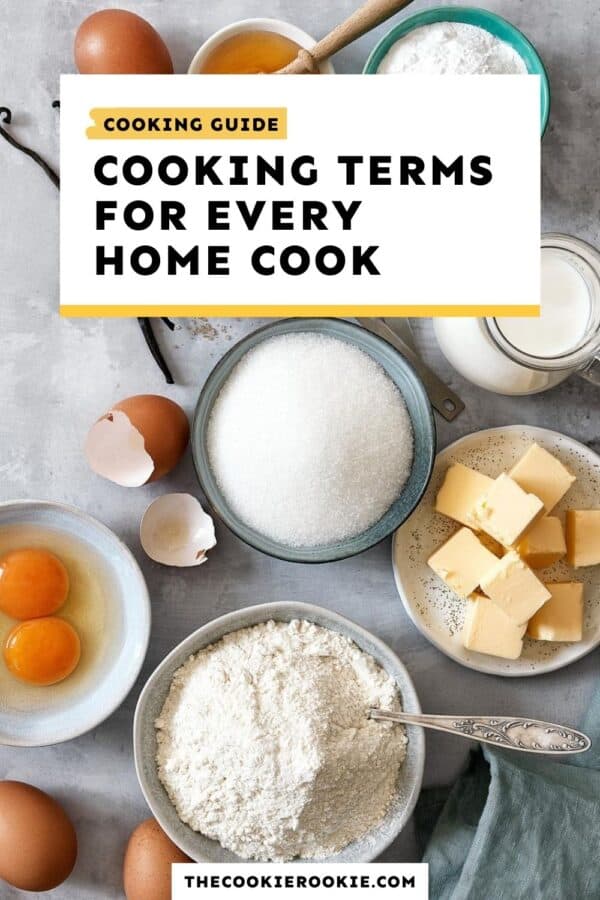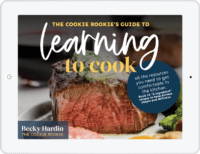This list of common cooking terms, definitions, and techniques will help you follow recipes and learn to cook at home with ease!

This post may include affiliate links that earn us a small commission from your purchases at no extra cost to you.
Cooking Terms and Definitions
Part of learning how to cook is learning how to decipher recipes. Sure, following directions seems simple enough, but if you don’t understand the cooking terms they use, then you’re not going to get very far.
Let it simmer, fold in the ingredients, chop (but don’t dice!), blanch the vegetables…but what does any of it mean?
All of these cooking definitions and techniques are things you will naturally learn along the way. But I’m here to make it a little easier by gathering all of the basic cooking vocabulary for you in this list, so you know where to look next time a recipe stumps you!
It’s important to know your basic cooking terms when you’re learning to cook. We are here to help!
Basic Cooking Terms and Definitions
From A-Z, here are the most common cooking terms you might need to know while following recipes and cooking at home!
Al dente
This Italian term translates to “to the tooth”, and means to cook pasta just until it starts to soften. It’s considered the ideal firmness for pasta and only takes a few minutes of boiling. The pasta will feel “firm to the bite”, so it’s no longer hard or crunchy, but it has not yet become too soft or soggy.
Recipes to try: Pesto Baked Rigatoni, Baked Spaghetti, Chicken Alfredo, Pasta Pomodoro
Baste
Basting means to pour liquids over food during cooking. This technique is mostly used when cooking meat, and the liquid can be anything from melted fats (like butter), to marinades, or even juices that have released from the meat while cooking.
The process of basting requires checking the meat at regular intervals to pour more liquids back over it as it continues to cook. Using a baster or a brush makes this much easier, but you can also use a spoon to scoop up juices and pour it back over.
Basting helps to keep meat moist during the cooking process and can also add flavor.
Beat
To beat means to quickly and rigorously mix ingredients together. The aim is to incorporate a small amount of air in the process (but not quite as much so as if a recipe tells you to whip). This technique is easiest to do with an electric mixer, but it can be done by hand.
Blanch/Blanching
Blanching is the process of briefly plunging vegetables (or sometimes other foods) into boiling water, and then slowing or halting the cooking process by shocking them in ice water. This allows them to retain their peak crispness, flavor, and color.
This method is often used as a way to pre-cook vegetables to ensure they’re fully-cooked during another method. It can also be used to prepare fresh veggies for freezing or preserving.
Learn how to blanch vegetables, step by step!
Blend
To blend means to combine multiple ingredients together until they become one smooth mixture. Blending can be achieved by mixing by hand (using a spoon, whisk, or other utensil), or by using a blender or electric mixer.
Blind Baking
Blind baking is most often used with pie crusts (and sometimes other pastries). This means to bake the crust before filling it. This method is used when making a pie with an uncooked, or partially-cooked, filling. Basically, it allows you to fully cook the crust without cooking (or overcooking) the pie filling.
Recipes to try: Fudge Brownie Pie, Easy Banana Cream Pie
Boil
As a cooking method, this means to cook food in boiling water (or another boiling liquid). It requires heating the water to its boiling point (212°F / 100°C) and then submerging the food in it until it is cooked through. Water will be bubbling heavily when it reaches boiling point.
Recipes to try: Easy Mashed Potatoes, How to Boil Ground Beef, Boiling Corn on the Cob
Braise
Cooking food in a small amount of liquid at a low temperature, usually for a longer period of time. This is typically used to cook tougher cuts of meat in order to make them tender and juicy. Foods are typically seared, sauteed, or pan-fried before cooking in liquid.
Brine/Brining
Brining means to soak food in a salt water solution (the brine). Soaking meat in brine before cooking allows it to absorb salt, which tenderizes it and helps it to retain moisture while cooking. You can also adds herbs, spices, and other ingredients to the brine to infuse the food with more flavor.
Recipes to try: Crockpot Turkey Breast, Juicy Smoked Turkey, Garlic Butter Turkey Breast, Whole Roasted Chicken, Peruvian Chicken
Broil
Broiling means to cook something under intense and direct heat (similar to grilling). At home, this is typically done in an oven by placing food directly under the broiler (tends to be at the top of the oven but may be in a separate compartment).
You can cook food fully by broiling, or use it for just a few minutes at the end of the cooking process to brown the skin/outside of the food and add a final layer of flavor.
Recipes to try: Broiled Hamburgers
Browning
Browning food means to partially cook it over high heat in order to form a brown “crust” on the surface (without fully cooking the interior). This method should generally be combined with another method to finish cooking it.
This technique adds a nice brown color but also adds flavor. It’s mostly used with meats.
Recipes to try: Bourbon Brown Sugar Salmon, Restaurant Style Steak
Caramelize
Caramelizing is the heating and browning of sugars to bring out flavor. This is part of the process used to make caramel, but you can also caramelize any food that naturally contains sugar. The most common example of this is caramelized onions.
To caramelize food requires cooking it at a high direct heat so that it starts to break down and release its natural sugar, until it browns and takes on a naturally “sweet” flavor.
Recipes to try: Caramelized Onion Dip, Caramelized Carrots, Candied Sweet Potato
Chop
To chop means to cut into pieces. These pieces will typically be bite-sized, but still larger than if you were to dice or mince.
Recipes to try: How to Cut an Onion
Cream
To cream as a baking technique (rather than as an ingredient) means to beat a solid fat into a soft, fluffy consistency while combining it with other ingredients at a high speed. This technique is used often in baking and is mainly used to combine butter and sugar.
Deglaze
Deglazing is a process of using liquid and heat to remove all of the caramelized, stuck-on pieces of food from a pan after cooking. It is common to then use those bits to add more flavor to the rest of your dish.
This technique involves adding a liquid (such as water, wine, stock, etc.) into the pan after cooking something (like meat, for example), heating it, and then using a spatula to scrape those leftover bits off the pan and into the liquid. This is a great way to make a stock or glaze that you can then pour over the food.
Dice
To dice means to cut into small, uniform, often cubed pieces (smaller than a chop but larger than minced). A dice might be anywhere from about 1/8- to 1/4-inch pieces.
Recipes to try: How to Cut an Onion
Dredge
Dredging means to coat food in a dry coating (such as flour and/or breadcrumbs) before cooking. It’s often combined with a wet ingredient, like eggs or milk, to make the dry ingredient stick.
For example: to make fried chicken, you would dredge chicken (dip in milk/buttermilk and then seasoned flour mixture) before frying it.
Recipes to try: Oven Fried Chicken, Avocado Fries, Fried Goat Cheese Balls, Breaded Pork Chops, Loaded Mashed Potato Bites
Emulsify/Emulsion
To emulsify means to combine a fat-based liquid (oil) with a water-based liquid to form a single mixture (an emulsion). This requires whisking rigorously while slowly adding one ingredient into the other.
Since oil and water do not easily or fully combine, these mixtures tend to separate into distinct layers after sitting for a while. You can use a third ingredient as an emulsifier (egg yolks are commonly used) to help stabilize the mixture.
A good example of an emulsion in cooking is vinaigrette dressings, which are a mixture of oil and vinegar (among other ingredients for flavor).
Folding
Folding or folding in means to gently combine ingredients into one without stirring or aggressively mixing. To do this, you will use a spoon or rubber spatula to lift and turn the mixture back into itself, repeatedly, until ingredients are combined.
Grate
To grate something means to rub the food against a grater in order to shred it into small pieces (for example, grating a block of cheese into shreds).
Julienne
Julienne is a knife-cutting technique. This means to cut food (often vegetables) into long, thin strips.
Knead
Kneading is part of the process of making dough for bread and pastries. Using your hands to work, shape, and stretch the dough to strengthen it into its final form before baking.
Recipes to try: Dutch Oven Bread, Homemade Sandwich Bread
Macerate
Macerating means to soak food in liquid until it softens or breaks down, with the aim of infusing the food with more flavor. This method is often used with fruit (like strawberries). Add sugar to the fruit to release the liquids, let the fruit soak in that liquid, and it will become super sweet and sauce-like.
Recipes to try: Mango Salsa, Strawberry Salsa Dip
Marinate/Marinade
Marinating is the process of soaking food in a marinade before cooking to add flavor.
A marinade is a liquid that can be made with a mix of ingredients (spices, sauces, vinegar, juice, etc.), and is often on the acidic side.
Marinating is most often used with meat, poultry, and fish. Typically you would make a marinade, place it in a container with the meat, and place it in the refrigerator for a period of time to let it soak in the flavor and moisture, then proceed to cook the meat.
Recipes to try: Yogurt Marinated Chicken, Steak Marinade
Mince
To mince means to cut into very small pieces (smaller than dicing). Typically, if a recipes says to mince, cut the pieces about as as small as you can.
Parcooking/Parboiling
Par-cooking means to partially (par) cook something. This can be done as a way to prep foods ahead of time, or if you want to use multiple cooking methods for one food/dish.
For example, you might parcook chicken on its own before adding it into a casserole with other ingredients to bake. This ensures that chicken is fully cooked during the short baking time.
A common type of par-cooking is par-boiling, which means to partially cook food by boiling first.
Recipes to try: Mashed Sweet Potatoes
Poach
Poaching is a cooking method that involves submerging food in a small amount of liquid and cooking it at a very low temperature.
This technique is similar to simmering, but uses an even lower temperature. It works great for cooking more delicate foods (like eggs, salmon, vegetables, or chicken).
Recipes to try: Poached Chicken Breast
Reduce
When a recipe tells you to “reduce the sauce” (or another liquid), it means to cook (usually by simmering) until the liquid actually reduces by volume. Water evaporates during this process, which is how it reduces.
The point of this technique is to make the sauce/liquid more concentrated in flavor and to thicken it.
Recipes to try: Balsamic Reduction
Roast
Roasting is a cooking method that uses dry heat/hot air to cook food from all sides at a high temperature. For most of us, that means using the oven. Roasting often adds a crispy, browned surface to the food.
Recipes to try: Pork Crown Roast, Roasted Turkey, Prime Rib Roast, Slow Cooker Pot Roast
Roux
A roux is a mixture of flour and fat that is added to sauces to thicken them.
To make a roux, cook flour and fat (butter is commonly used) together on the stove, and mix until it’s smooth and reaches desired brownness/color. This mixture can then be combined with the sauce/gravy.
Recipes to try: Creamy Chicken Soup
Saute
Sautéing means to cook food in a shallow pan, using a small amount of fat/cooking oil at a high temperature.
Recipes to try: Sauteed Asparagus, Sauteed Green Beans, Garlic Butter Shrimp
Score
To score food means to make shallow cuts into the surface of the food. This is mostly done with breads/pastries and meats.
The point of scoring foods is to control the cooking. With more surface of the meat exposed through scoring, it cooks more evenly (which is helpful with denser cuts of meat).
With breads, scoring helps to control the release of gas (from the yeast) that naturally occurs while baking (so you don’t end up with random holes/ruptures in your loaf).
Scoring also makes for a nice decorative flourish.
Sear
To sear something (usually meat/poultry/fish) means to cook it briefly at a high temperature in a pan until the skin browns. It’s a great way to add color and flavor to the skin without overcooking the inside. Searing is often used as an extra touch before or after cooking it by another method.
Recipes to try: Pan Seared Chicken Breast, Pan Seared Salmon, Pan Seared Ribeye
Season to Taste
When a recipe instructs you to “season to taste” (often in reference to salt and pepper), it means to add as little or as much seasoning as you like (to your taste). So add a small amount of seasoning at a time and taste, until you get the flavor you want.
Simmer
Cooking (either cooking food in liquid or cooking a liquid-based food, like soup) over medium heat, so that it is not quite boiling. This requires bringing it to a boil and then immediately lowering the temperature to a steady medium heat.
Recipes to try: Creamy White Chicken Chili, Chicken Tacos Soup, Parmesan White Bean Soup
Sous Vide
When translated literally from French, sous vide means “under vacuum”. This method involves placing food in a sealed container (a bag, a jar, etc.), and then cooking it at a low temperature, for a long time, in a water bath.
This is one of the best methods to get moist, evenly-cooked results. Since the water temperature is set to the temperature you want the food cooked to, it will never overcook. It does, however, take longer than other cooking methods.
Recipes to try: Sous Vide Chicken Breast
Whip
To whip means to beat an ingredient or mixture (using a whisk or mixer) in order to add air into the mixture and produce a light, fluffy result.
Recipes to try: Pumpkin Spice Whipped Cream, Stabilized Whipped Cream, Whipped Goat Cheese Bruschetta
Zest
When a recipe calls for “zest”, it means to scrape off bits of citrus fruit peel (lime zest, lemon zest, etc.) to add into the dish. Zest is used to add flavor to dishes, and sometimes used simply as garnish. Using a zester is the best way to do this.
Now that you have all of the basic cooking terms and definitions figure out, reading and following recipes at home will be so much easier. Be sure to bookmark this so you can return any time you need a refresher!







I am searching for an answer to the following question, and so far have been unable to get an answer from any source. If you can help me it will be much appreciated!
I have a question instead of a review, but I hope you can help me,
I do not have a question, only a poser of a question. The question is:
When mixing up a recipe, and adding ingredients, all at once I run across an ingredient that says 1 measure of sugar, instead of 1 Tablespoon of sugar. Whoa, a measure? What the hell is a measure. No matter where I have looked I cannot find the answer. Is it a teaspoon? is it
a Tablespoon? Is it a gallon? Nah, couldn’t be a gallon But what is the answer to this secret, or taboo question? Thanks for any help you can give me!!!
a tablespoon? Is it a cupful? Maybe it is a gallon, nah couldn’t be, but how much is it? Can you help me find the answer to this apparently secret secret? Thank you
Hi Larry, generally speaking, when a recipe calls for, say, 1 measure of sugar to 2 measures of butter, it is referring to an infinitely scalable ratio of ingredients. That would include measurements like 1 teaspoon of sugar to 2 teaspoons of butter, 1 tablespoon of sugar to 2 tablespoons of butter, or even 1 cup of sugar to 2 cups of butter. We have not heard of a recipe where “measures” of ingredients are mixed with cups, tablespoons, grams, etc. Hope this helps!